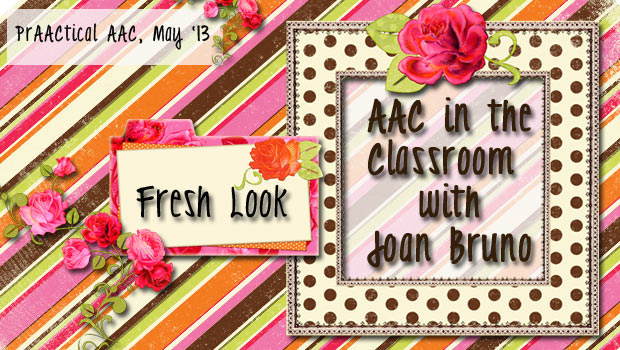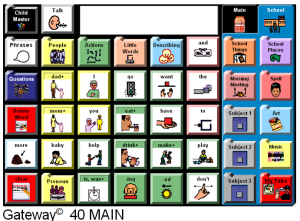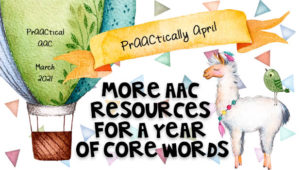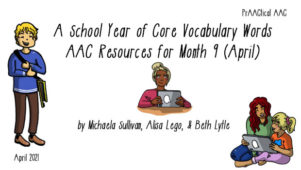Fresh Look: AAC in the Classroom with Joan Bruno

We’re off to a great start for Better Hearing and Speech Month! Today’s Fresh Look post comes from one of the most experienced AAC SLPs in the United States. Joan Bruno, Ph.D., CCC-SLP has over 30 years experience working in the field of AAC. She is currently maintains a private practice consulting to schools and private agencies and is the Augmentative Communication Specialist at the TECHConnection in Shrewsbury, NJ. Joan has  published and presented nationally and internationally on a variety of topics related to AAC assessment and intervention. Joan is the 2011-2013 President of the New Jersey Speech and Hearing Association, and a Past-President of the United States Society for Augmentative and Alternative Communication. Since 1992, she has directed Camp Chatterbox, a therapy camp for children using AAC devices. Joan is the author of the Gateway to Language and Learning© page set and the Test of Aided-Communication Symbol Performance© (TASP). In this post, Joan shares some thoughts on promoting language competency withing the language arts component of the school day.
published and presented nationally and internationally on a variety of topics related to AAC assessment and intervention. Joan is the 2011-2013 President of the New Jersey Speech and Hearing Association, and a Past-President of the United States Society for Augmentative and Alternative Communication. Since 1992, she has directed Camp Chatterbox, a therapy camp for children using AAC devices. Joan is the author of the Gateway to Language and Learning© page set and the Test of Aided-Communication Symbol Performance© (TASP). In this post, Joan shares some thoughts on promoting language competency withing the language arts component of the school day.
SLP’s who work in the schools are faced with many challenges when providing AAC intervention to students within a regular classroom setting. At the same time, SLPs have tremendous opportunities to support these while simultaneously working on AAC intervention goals. A natural environment is an ideal setting for providing AAC intervention. When a student learns in context, the outcome is can be powerful.
In the early elementary years, subjects such as math, science, and social students provide wonderful opportunities for students using an AAC device to participate in class and to demonstrate their mastery of core curriculum standards. Topical vocabulary related to each subject can be programmed into devices, or other strategies such as multiple-choice questions, can be used. These subjects can promote device use, but they may not be the best choice of the goal is to help your students improve their expressive language abilities.
Reading and especially Language Arts provide excellent opportunities to address language-related goals. Most often regular and special education teachers do not share the same level of expertise in understanding language development and disorders. Some students are given too much support and they may never master the ability to write a well-formed sentence. Other students are assumed to have more advanced skills than they truly possess do not receive adequate instruction. In my opinion, Reading and Language Arts should be the subjects of choice for SLP’s providing services in the classroom.
It goes without saying that collaboration with the teacher is required in order to know the topic and vocabulary being addressed. But with a strong background in language development and disorders, the SLP is best suited to take the lead in supporting the student in the area of written language while complementing spoken communication goals. Spoken and written language abilities go hand in hand. Students are not going to write at a more advanced level than they can speak.
There are 5 Key Areas of Aided Language Intervention that SLP’s can address by working in Language Arts setting.
1. Teaching Use of Core Vocabulary. Student’s need to master the contents and location of their Core Vocabulary if they are to use those words to speak or write. But, knowing the content and location is just one part of the solution. Understanding when and how to use these words within a functional communication context is critical to the student’s success in both speaking and writing. “Make”, “Go”, “See”, and “Have” are just a few powerful core vocabulary words. Help your students learn to use these words, by modeling their use in their written assignments. As these words are mastered help select expand the core.
2. Increasing Message Length. Many students who use AAC speak using telegraphic messages. If your student does, let these telegraphic messages serve as the baseline for their written communication performance. Help them learn to use longer sentences by adding adjectives and adverbs that the student clearly understands, but has not yet, learned to add when generating spoken or written messages.
3. Expanding Use of Morphological Markers. Students who are not communicating using well-formed sentence structure are going to struggle when expected to write using syntactically correct sentences. As an SLP with an understanding of your student’s developmental level and expressive language abilities can not only help teach your student to use present progressive verb tense or past tense, but you can help the classroom teacher establish appropriate written expectations for the student.
4. Improving Word Order. Many students using AAC systems compose messages using a string of content words. Their spoken and written messages do not reflect proper word order. As an SLP we can help these students learn to observe the rules of written discourse. We can use tools such as the Fitzgerald Key, to provide a visual framework for teaching students to write a simple declarative sentence. Many AAC page sets already utilize this color-coding framework. You can help to make it come alive in written language tasks. A sample manual board designed using the Fitzgerald Key framework can be found at http://ctr-nj.com/resources/. Below is a sample page from Gateway to Language and Learning© which demonstrates the use of the Fitzgerald Key on a dynamic display communication device.
5. Spelling and Word Prediction. For a user of an AAC system, the ability to spell can eliminate the restrictions imposed by needing to rely on a closed vocabulary set. Helping students learn to improve their sight word recognition abilities and/or learn to spell is an important area of intervention.
Filed under: PrAACtical Thinking
Tagged With: core vocabulary, curriculum, Fresh Look, general education, inclusion, Joan Bruno, Language Arts, schools, word prediction
This post was written by Carole Zangari





